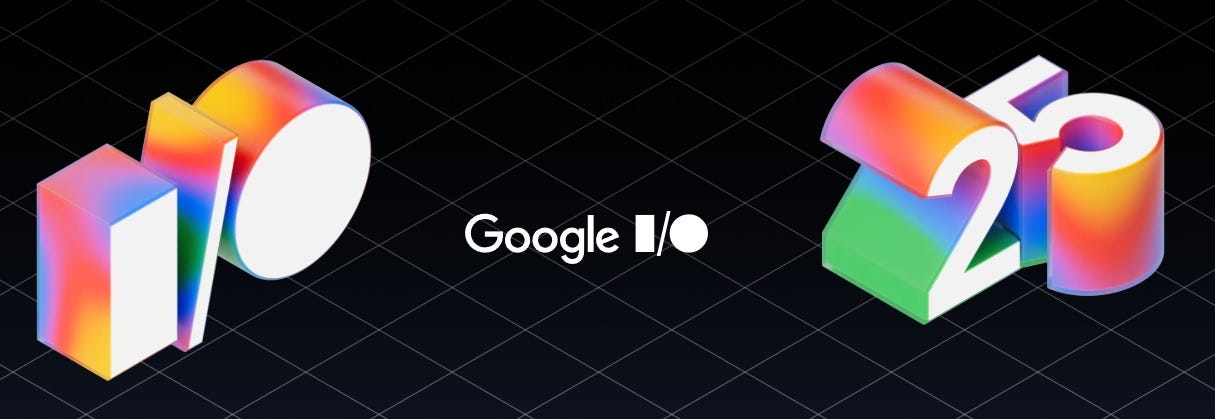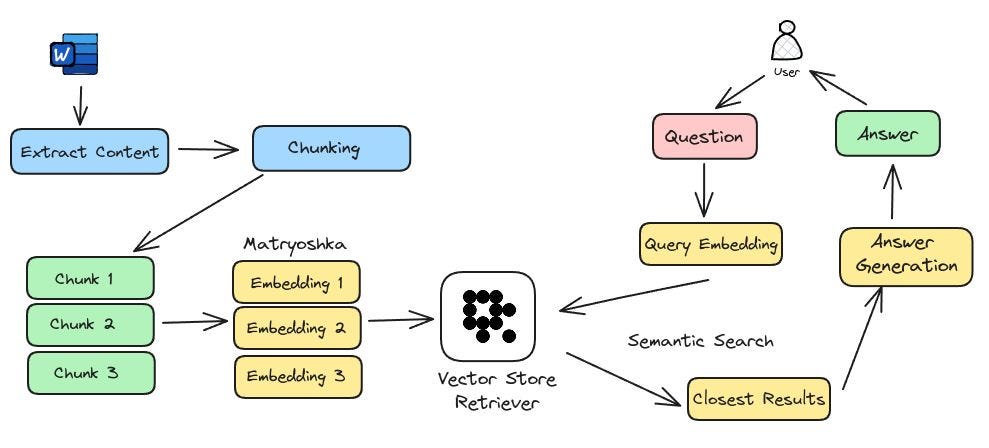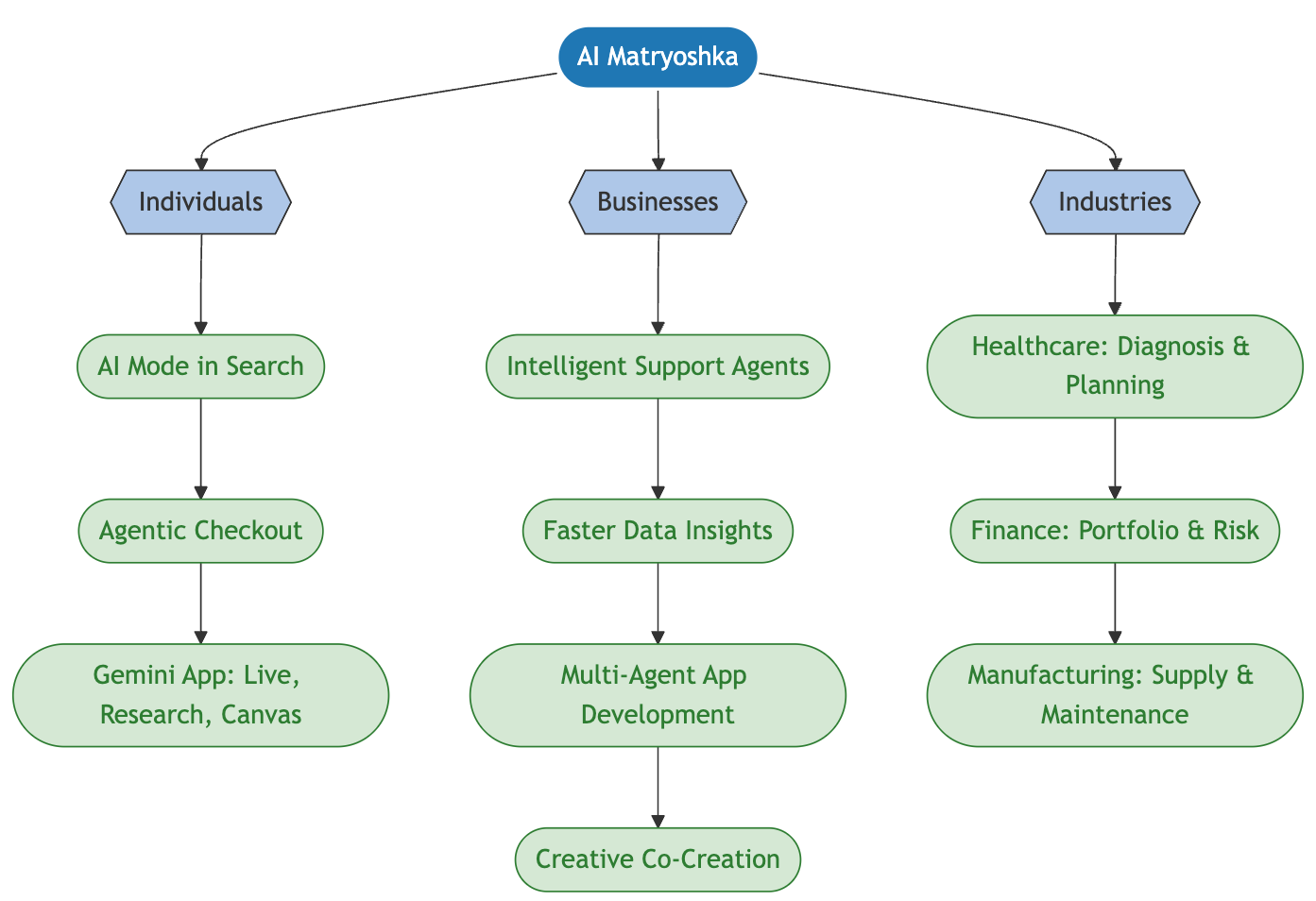Google’s AI Matryoshka
A comprehensive, AI first restructuring of it's entire product ecosystem.
Get ready to dive deep into the latest innovation from Google that's set to reshape the landscape of artificial intelligence: AI Matryoshka. Unveiled at the recent I/O Developers Conference 2025, this strategy isn't just an update, it's a fundamental re-architecture of how AI powers Google's entire ecosystem, from its core models to the applications you use every day. This is truly Where's The Future in Tech!
In this newsletter, I’ll break down:
What are Matryoshka Models?
How they differ from traditional AI architectures.
Technical underpinnings & innovations.
Comparisons with models like GPT-4, Claude, and traditional Gemini.
Real-world applications.
Future prospects.
What are Matryoshka Models?
Imagine a set of Russian nesting dolls, each one a progressively smaller and more refined version nestled within the larger. Google's AI Matryoshka operates on a similar principle. At its heart lies a central, powerful AI intelligence driven by the advanced Gemini 2.5 models (Pro and Flash versions). This core intelligence then powers successive layers of Google's platforms, including APIs, developer tools, and ultimately, user applications and hardware.
This isn't just about making individual AI models better, it's about making AI the fundamental operating principle across Google's entire stack. It signifies a transition from disconnected AI tools to a cohesive system where AI is not just a feature, but the core engine, anticipating, understanding, and acting on user needs in real-time. It's about designing intelligence that scales and adapts, from high-level strategic functions down to granular, everyday tasks, all drawing from the same core wellspring of AI power.
How They Differ from Traditional AI Architectures
Traditional AI often uses specialized, siloed models for specific tasks. Even large language models (LLMs) usually operate at a fixed size. Matryoshka fundamentally differs:
Integrated intelligence vs. Disparate tools: Matryoshka creates a unified AI fabric, allowing seamless context sharing and collaborative problem-solving across all applications and services.
Hierarchical scalability: This is the core Matryoshka magic. It allows for dynamic scaling of computational intensity. You can use a smaller, efficient "inner doll" for simple tasks, only tapping into the powerful "outer dolls" (the full model or detailed embeddings) when complexity demands it. This drastically improves efficiency and reduces latency.
Agentic systems: Matryoshka heavily emphasizes "agentic" AI systems that can reason, plan, and execute multi-step tasks autonomously. They can initiate actions, communicate with other AI agents, and adapt behavior, moving beyond simple chatbots.
Technical Underpinnings and Innovations
This ambitious vision is built on several cutting-edge innovations:
Deep integration of Gemini 2.5: These latest models are Matryoshka's beating heart.
Gemini 2.5 Pro with "Deep Think" mode: This enables enhanced reasoning and a more deliberate, multi-step thought process. It allows the AI to "mull over" complex problems, providing nuanced understanding and strategic planning, crucial for scenarios demanding high accuracy.
Gemini 2.5 Flash: Optimized for speed and efficiency, Flash is lightweight, consumes fewer tokens, and delivers rapid responses for everyday tasks. This balance ensures AI is ubiquitous and responsive without prohibitive costs.
Next-Gen hardware: TPU v7 (Ironwood): AI models are incredibly compute-intensive. Ironwood, Google's 7th-generation Tensor Processing Unit, is engineered specifically for AI workloads. It offers a staggering 42.5 exaFLOPS per pod a tenfold performance increase over previous generations. This immense power is crucial for training and running complex Gemini models in real-time, making the Matryoshka scale feasible.
Expanded developer tools: Google aims to foster an ecosystem by providing powerful tools for building on this foundation.
Model Context Protocol (MCP): A game-changer for multi-agent AI, MCP standardizes how different AI agents communicate and share context. This allows agents to "understand" each other's status and goals, simplifying development of complex, collaborative AI systems.
"Thinking Budgets": Developers can allocate computational resources, or "thinking budgets," to different AI tasks. A simple query gets a small budget, while complex data analysis gets a larger one, optimizing resource allocation and reducing operational costs.
Matryoshka embeddings: This is a brilliant technical marvel, acting like the clever, hidden hinges that allow each doll to nest perfectly.
What are they? Embeddings are numerical representations of data. Matryoshka embeddings are designed so that the initial dimensions contain the most critical information, and subsequent dimensions add finer details. This means you can "truncate" them (use a smaller subset of dimensions) and still retain high meaningful information.
Efficiency & Scalability: For quick, coarse-grained tasks like initial search filtering, you can use small, low-dimensional embeddings, saving memory and speeding up computations. For tasks requiring higher precision, you switch to larger, more detailed versions of the same embedding.
Improved accuracy: The genius is that even truncated embeddings maintain high accuracy. This overcomes a major challenge in traditional AI, making applications faster, more resource-efficient, and ultimately, more scalable without sacrificing quality.
Comparisons with Models like GPT-4, Claude and Traditional Gemini
While GPT-4, Claude, and earlier Gemini versions are powerful LLMs, Matryoshka represents a fundamental shift in AI deployment and integration.
Beyond the LLM: Matryoshka focuses on an entire ecosystem powered by AI, not just a standalone powerful model. Gemini 2.5 models are at its core, but the strategy emphasizes their deep integration and dynamic scalability across all Google products and platforms.
Architectural flexibility: Matryoshka Embeddings and "thinking budgets" enable a level of architectural flexibility and resource optimization not explicitly central to GPT-4 or Claude. It allows for intelligent "downsizing" of AI computational load.
Agentic focus: With the Model Context Protocol, Matryoshka explicitly positions agentic interaction and inter-agent communication as central. This suggests a more native, integrated approach to building complex, autonomous AI workflows.
Hardware-Software Co-design: Google's tight integration of TPU v7 with Gemini 2.5 highlights their long-standing commitment to bespoke hardware-software co-design, offering unique optimization advantages for such a unified strategy.
"Deep Think" vs. Raw performance: The emphasis on "Deep Think" mode in Gemini 2.5 Pro points towards a focus on complex reasoning and problem-solving beyond just raw output generation speed, aiming for higher fidelity intelligence.
Real-World Applications
The implications of AI Matryoshka are far-reaching, promising to reshape how we interact with technology across various sectors:
Enhanced productivity for individuals: "AI Mode" in Search provides synthesized, cited answers with multimodal reasoning, cutting down research time. "Agentic Checkout" streamlines online shopping by automating tedious steps. Gemini App enhancements like "Live mode," "Deep Research," and "Canvas" turn Gemini into a versatile personal assistant and creative co-pilot.
Upgrading business operations: From highly intelligent customer service agents to rapid data analysis and insights, businesses can leverage Matryoshka for hyper-personalized support and faster decision-making. Developers can build more sophisticated, multi-agent applications, accelerating innovation and automation. Creative industries will find AI an indispensable co-creator.
Industry-Specific transformations: Expect AI assistance in healthcare for diagnosis and treatment planning, in finance for portfolio management and risk assessment, and in manufacturing/logistics for optimizing supply chains and predicting equipment failures.
Future Prospects
The AI Matryoshka strategy is a bold leap, bringing both exhilarating prospects and significant challenges.
Future Prospects:
Ubiquitous, Invisible AI: AI will become seamlessly integrated and proactive, leading to truly intuitive and hyper-personalized digital experiences.
True AI autonomy: Advanced agentic capabilities could lead to autonomous AI systems managing complex projects with minimal human oversight.
New modalities of interaction: Richer, more natural human-AI interaction will emerge, going beyond text to involve continuous voice, gestures, and real-world context awareness.
Democratization of Advanced AI: Efficient and scalable models via Matryoshka Embeddings could democratize sophisticated AI application creation, fostering an explosion of innovation.
Pushing scientific boundaries: "Deep Think" mode and immense TPU power open doors for AI to assist in complex scientific discovery and research.
Potential Challenges:
Data privacy and security: With extensive access to user data, robust safeguards, transparent policies, and granular user controls are crucial. The "privacy premium" could also be a concern.
Transparency and explainability: As AI agents make complex decisions, ensuring clear insights into their reasoning ("the black box" problem) is vital for trust and accountability, especially in critical applications.
Bias and Fairness: Preventing models from perpetuating societal biases present in training data will be an ongoing challenge requiring continuous auditing and fairness measures.
Job displacement and Economic impact: Autonomous AI systems will inevitably raise questions about job displacement and the need for new societal safety nets and reskilling initiatives.
Misinformation and Malicious use: Powerful generative and reasoning AI, deeply integrated, presents an amplified risk for spreading misinformation or being used for malicious purposes, requiring continuous vigilance.
Regulatory scrutiny: Such a deeply integrated AI ecosystem will attract significant regulatory scrutiny regarding data governance, algorithmic bias, and accountability, making navigating this evolving landscape a critical challenge.
Google's AI Matryoshka is a bold statement about the future of artificial intelligence. It's a strategic repositioning of AI at the very core of a global technology giant. As we at Where's The Future in Tech monitor its rollout, we'll be keenly observing how these powerful capabilities are balanced with critical ethical and societal considerations.
What aspects of AI Matryoshka are you most excited (or concerned) about? Let me know in the comment section!
Until next time,
Stay curious, stay innovative and subscribe to us to get more such informative newsletters.
Read more of WTF in Tech newsletter:










